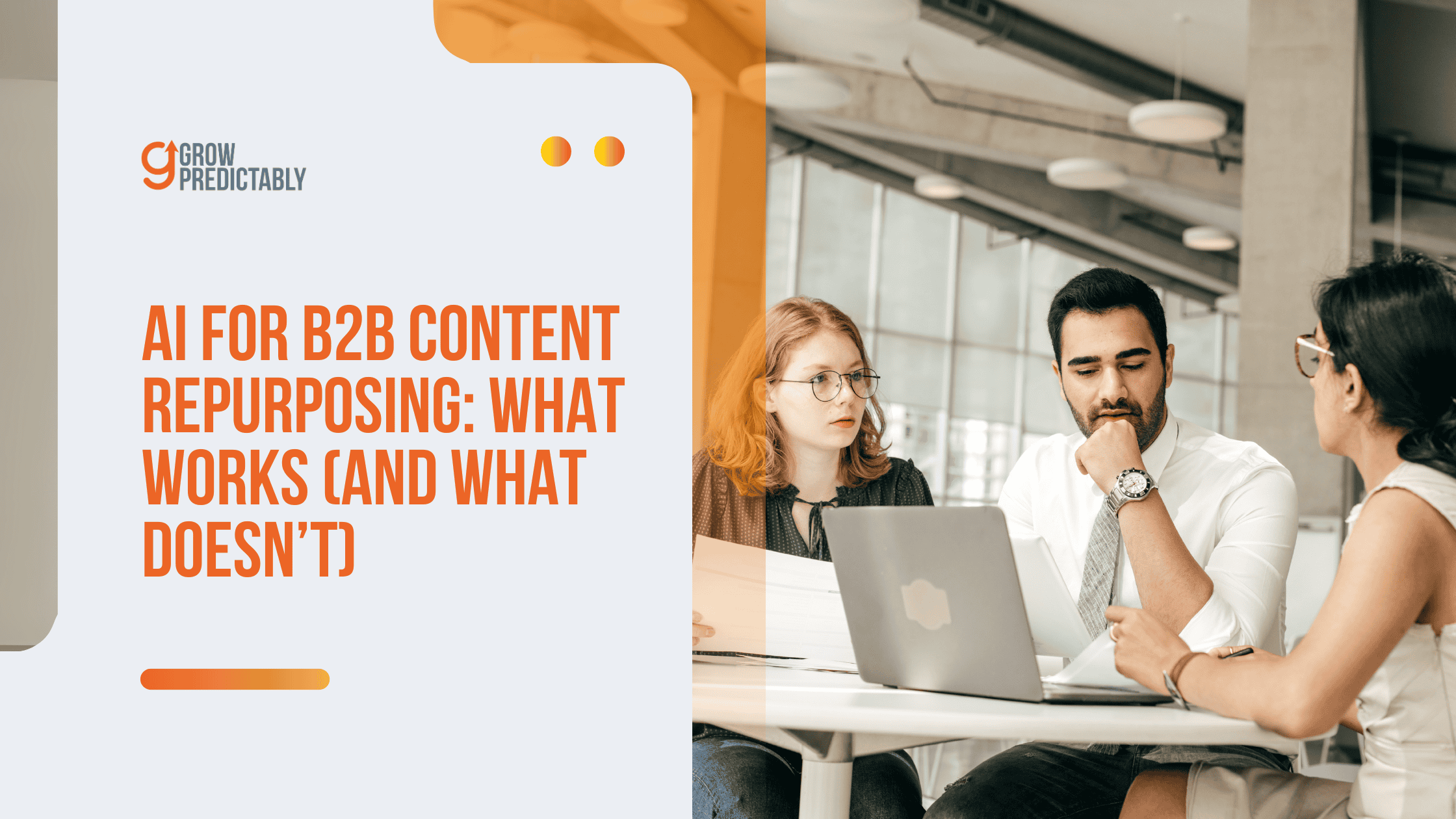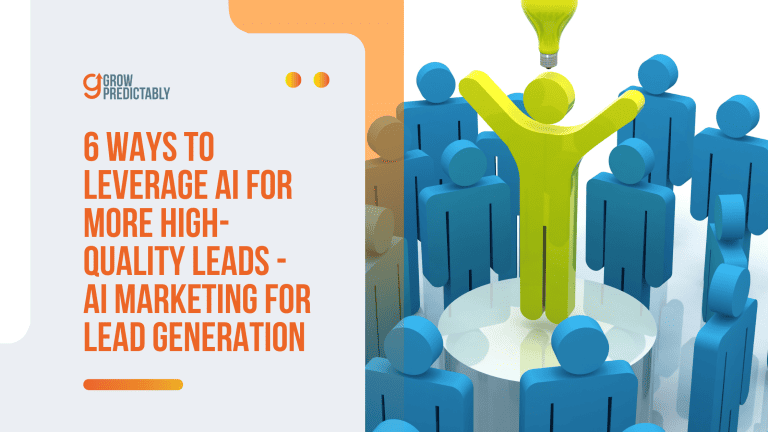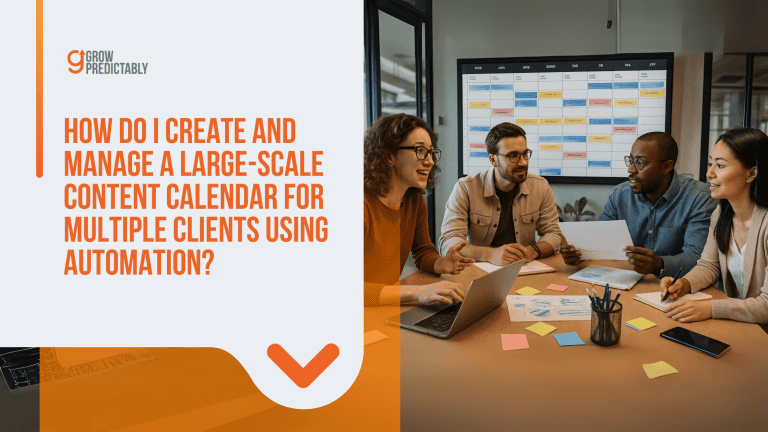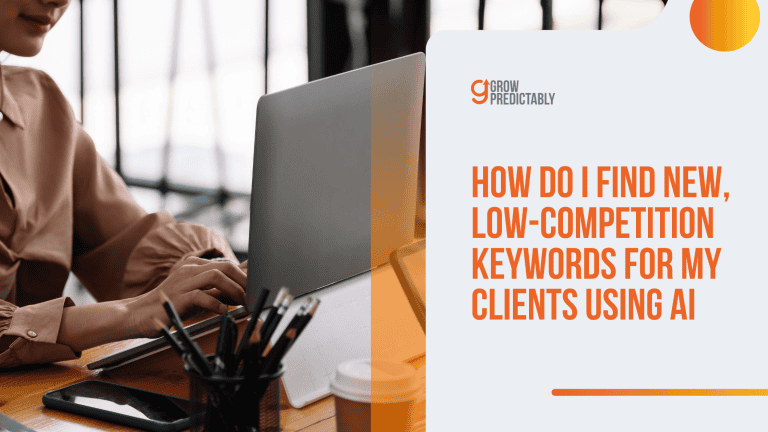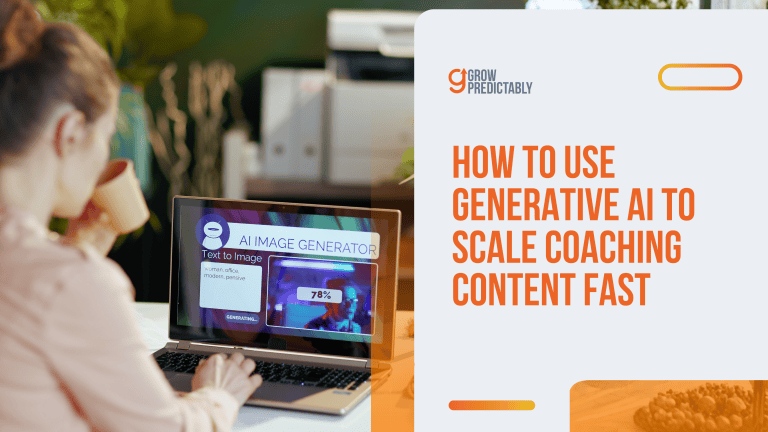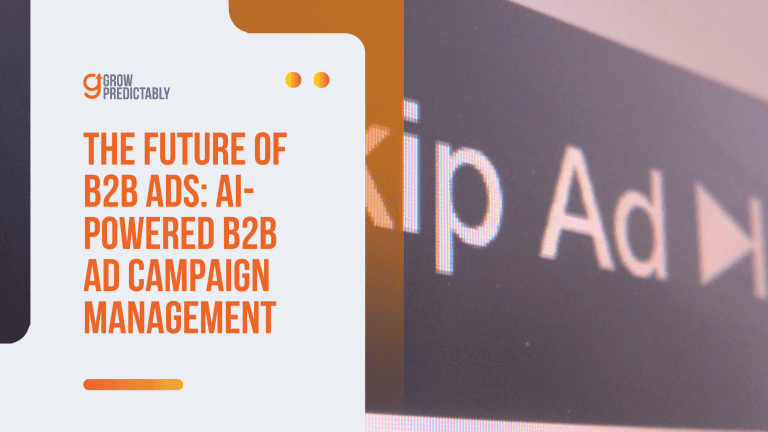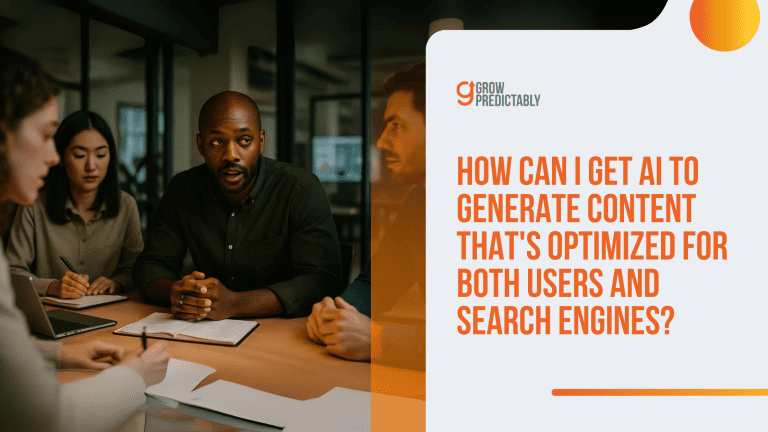AI for B2B Content Repurposing: What Works (and What Doesn’t)
You know that feeling when you look at your content calendar and want to hide under your desk?
You need to write 30 blog posts, create 50 social media posts, and fill 12 newsletters this quarter.
Where do you even start?
Or maybe you’re the person who writes amazing blog posts that get shared once and then disappear forever.
You put in all that work, and then… nothing.
Here’s something crazy: 65% of marketers agree that repurposing content is more cost-effective than creating new content from scratch.
And here’s the kicker – 48% of B2B content marketers say their biggest challenge when scaling content is “not enough content repurposing”.
What if you could make your content work harder without you working harder?
AI powered repurposing is a game-changer for maximizing the value of your existing content across multiple platforms and audiences.
Learning how to use AI for B2B content repurposing isn’t just a nice trick anymore – it’s how you stay in the game.
When you get good at this, you turn one blog post into a whole bunch of valuable content that brings in leads while you sleep, ensuring your material remains relevant and impactful.
Keep reading to find out exactly how to turn one piece of content into a month’s worth of posts.
You’ll see why some companies seem to be everywhere online while others can barely keep up with posting once a week.
TL;DR
AI enhances B2B content repurposing by analyzing audience data to tailor content formats to preferences across the customer journey. It streamlines content transformation, enhancing relevance and productivity. However, blindly automating without strategic oversight can diminish personalization and resonance. To maximize impact, integrate AI insights with human creativity.
KEY TAKEAWAYS
- Define and continuously update customer avatars with AI-driven insights to keep content relevant and tailored to audience needs.
- Leverage AI to automate repetitive tasks and gather data, freeing up your team to focus on strategic and creative enhancements.
- Incorporate systematic feedback loops to refine content strategies based on actual customer interaction and effectiveness.
Understanding Your Audience: The Foundation of Effective Content Repurposing
Most people get this backwards.
They create content first, then try to figure out who wants to read it.
That’s like cooking a meal and then looking for someone who’s hungry.
You’ll waste time, money, and end up with content that nobody cares about.
Your ideal customer is already out there searching for answers.
They have specific problems keeping them up at night, goals they’re desperate to reach, and they consume content in very particular ways.
Analysing audience data helps you understand these needs and preferences, so you can create content that truly resonates.
When you know exactly who you’re talking to, every piece of content you repurpose becomes a laser-focused solution instead of a generic post hoping for attention.
The aim of marketing is to know and understand the customer so well the product or service fits him and sells itself.”
Peter Drucker, Management Thought Leader
Building Your Customer Avatar
Think of your customer avatar as building a detailed profile of your perfect customer.
This isn’t some fluffy marketing exercise – it’s the difference between content that converts and content that gets ignored.
Your avatar includes who they are (job title, company size, industry), what problems make their life difficult, what success looks like to them, and how they prefer to consume information.
Here’s what you need to know about your ideal customer to make content repurposing actually work:
- Demographics and role: Are they CEOs of 50-person companies or marketing managers at Fortune 500 firms? Their level of authority changes how you talk to them
- Daily challenges: What specific problems do they face every Tuesday at 2 PM? The more specific, the better your content hits
- Success metrics: How do they measure wins? Revenue growth, time savings, team efficiency? Your content needs to connect to their scoreboard
- Content preferences: Do they read long reports during lunch or scroll through LinkedIn posts between meetings? Format matters as much as message
- Decision-making process: Do they make quick decisions or need to convince a committee? This affects how you structure your repurposed content
The beauty of having a clear avatar is that repurposing becomes obvious.
You take one piece of content and adapt it for different stages of their journey, different platforms they use, and different formats they prefer.
Instead of guessing what might work, you’re creating variations you know will work.
AI-Powered Customer Analysis
AI takes customer analysis from guesswork to data-driven precision.
Instead of making assumptions about your audience, you can analyze actual behavior patterns, engagement data, and customer feedback to build avatars that reflect reality.
Tools like customer data platforms and AI analytics can process thousands of customer touchpoints to identify patterns you’d never spot manually.
Machine learning algorithms are used to identify these patterns and segment audiences more effectively.
The process is straightforward but powerful.
AI can analyze your existing customer data to find common characteristics among your best customers, identify which content formats get the most engagement from different customer segments, and even predict which topics will resonate most with specific audience groups.
According to Salesforce, 76% of customers expect companies to understand their needs and expectations, and AI makes this level of understanding scalable.
What makes AI particularly valuable for content repurposing is its ability to segment your audience automatically, enabling the creation of personalized content for each segment.
You might discover that your C-suite audience engages most with short video summaries while your middle management audience prefers detailed written guides.
This insight lets you repurpose the same core content into formats that each segment actually wants to consume.
Before/After Transformation
Every piece of content you create should move your audience from their current frustrating situation to their desired outcome.
This transformation is what makes content valuable, and it’s what makes repurposing strategic instead of random.
Your audience has a “before” state where they’re struggling with specific problems, and an “after” state where those problems are solved.
When you understand this transformation clearly, repurposing becomes about creating different entry points and reinforcement for the same journey.
Your blog post might introduce the transformation, your LinkedIn carousel might highlight the key steps, your email sequence might provide detailed implementation, and your video might show the transformation in action.
The most effective content repurposing maps directly to this transformation journey:
- Problem awareness content: Helps people recognize they have an issue that needs solving
- Solution education content: Shows them what’s possible and builds belief that change is achievable
- Implementation content: Provides specific steps and tools to make the transformation happen
- Results reinforcement content: Demonstrates success stories and maintains momentum
Your repurposed content should consistently reinforce this transformation from multiple angles.
This approach also fosters meaningful conversations with your audience across platforms, deepening engagement and building authority.
When someone sees your LinkedIn post about a problem, then reads your blog post about the solution, then gets your email with implementation steps, they’re not seeing repetitive content – they’re getting a comprehensive system that guides them through their transformation.
This is how you turn content repurposing from a time-saving tactic into a revenue-generating strategy.
Mapping Content Repurposing to the Customer Value Journey (CVJ)
Your customers don’t just magically appear ready to buy.
They move through predictable stages from never hearing about you to becoming your biggest advocates.
The Customer Value Journey maps this exact path, and when you align your repurposed content with where someone is on this journey, every piece of content becomes more powerful.
Don’t find customers for your product. Create products for your customers.”
Seth Godin, Marketing Visionary Author
Before mapping your content, it’s essential to conduct a content audit to identify which assets are best suited for each stage of the journey.
Most businesses spray content everywhere hoping something sticks.
Smart businesses create content that meets people exactly where they are and moves them to the next stage.
This isn’t about creating more content – it’s about making the content you already have work harder at each stage of the journey.
Awareness Stage Content
People can’t buy from you if they don’t know you exist.
At the awareness stage, your job is simple: get in front of the right people with content that makes them stop and pay attention.
Your existing long-form content is perfect for this, but it needs to be broken down into bite-sized pieces that work on different platforms.
Take that comprehensive guide you wrote and turn it into social media gold by distributing it across key social media platforms.
AI can extract the most engaging statistics, compelling questions, and shocking revelations from your content to create posts that grab attention.
Your 3,000-word blog post becomes 15 LinkedIn posts, 30 Twitter updates, and 5 short videos that all point back to the original content.
Make sure to adapt each piece to the preferred content format of each platform, such as videos for TikTok or infographics for Instagram, to maximize engagement.
The key here is understanding that awareness content needs to be:
- Instantly valuable: Someone should learn something useful within 10 seconds of seeing your post
- Platform-optimized: A LinkedIn post needs different formatting than a TikTok video, even with the same core message
- Curiosity-driven: Your content should make people want to know more, not give them everything upfront
- Problem-focused: Address the pain points your audience is already thinking about
Your awareness content isn’t trying to sell anything. It’s building trust and establishing you as someone worth paying attention to.
When you repurpose strategically for awareness, you turn one piece of educational content into dozens of entry points for new prospects, helping you reach a wider audience beyond your initial followers.
Engagement Stage Content
Once people know you exist, they need reasons to stick around.
Engagement content takes your existing knowledge and makes it interactive, personal, and immediately useful.
Creating engaging content at this stage is crucial for fostering deeper relationships with your audience and encouraging ongoing interaction.
This is where AI really shines because it can personalize your content at scale.
Interactive quizzes work incredibly well here because they take your expertise and turn it into something people actively participate in.
That blog post about “10 Marketing Mistakes” becomes a quiz that helps people identify which mistakes they’re making.
Your comprehensive guide becomes a series of personalized emails that adapt based on someone’s specific situation and responses.
Research shows that interactive content generates 2x more conversions than passive content, and AI makes creating this interactive content from your existing material much easier.
You’re not starting from scratch – you’re taking proven content and making it more engaging.
The engagement stage is about building a relationship.
Your repurposed content should feel like a conversation, not a lecture:
- Personalized responses: AI can adapt your content based on someone’s industry, company size, or previous interactions
- Progressive disclosure: Reveal more valuable information as people engage more deeply with your content
- Two-way interaction: Ask questions, respond to comments, and encourage people to share their experiences
- Value-first approach: Give away your best insights freely to build trust and demonstrate expertise
Subscribe and Convert Stage Content
This is where your repurposed content needs to make a compelling case for why someone should give you their contact information or try your product.
Your existing content already contains the proof and value propositions you need – AI helps you package it for maximum conversion impact.
Chatbots powered by your content knowledge can answer specific questions and guide people toward signup.
Your comprehensive case studies become webinar presentations that end with clear calls to action.
Your detailed how-to guides become lead magnets that solve immediate problems while demonstrating your expertise.
The conversion stage requires content that builds confidence in your solution while removing barriers to taking action. Make sure your content communicates key messages that address audience concerns and drive action.
Your repurposed content should address common objections and provide social proof:
- Specific outcomes: Use real numbers and results from your existing case studies and success stories
- Risk reversal: Address what people are worried about when considering your solution
- Clear next steps: Make it obvious what someone should do after consuming your content
- Urgency without pressure: Show why acting now makes sense without being pushy
Excite and Ascend Stage Content
Your new customers need to see value quickly, and your existing customers need reasons to buy more.
Delivering high-value content at this stage is essential for maximizing customer satisfaction and retention.
This is where your educational content gets repurposed into onboarding sequences, advanced training, and upgrade justifications.
AI helps you identify which existing content works best for different customer segments and success levels.
Your comprehensive guides become personalized onboarding sequences that adapt based on how someone uses your product.
Your advanced case studies become upgrade recommendations that show what’s possible with higher-tier features.
Your industry insights become retention content that keeps customers engaged and growing.
The key is using your content to drive specific actions that increase customer lifetime value:
- Quick wins: Help new customers see value immediately with targeted, actionable content
- Progressive advancement: Show customers what’s possible as they grow and succeed
- Relevant recommendations: Use AI to suggest content and upgrades based on actual usage patterns
- Success reinforcement: Celebrate customer wins and show how your solution contributed
Advocate and Promote Stage Content
Your best customers become your best marketing when you give them the right tools and incentives.
AI can help you identify your most successful customers and turn their success stories into powerful marketing content that attracts similar prospects.
Customer testimonials become case study videos, social media campaigns, and referral program content.
Success stories get repurposed into different formats for different stages of the customer journey.
Your existing customer content becomes the foundation for building a community of advocates.
This stage is about making it easy and rewarding for customers to share their success:
- Story amplification: Turn customer successes into content that reaches their networks
- Referral tools: Provide customers with content they can easily share with colleagues
- Community building: Create spaces where customers can share experiences and learn from each other
- Recognition programs: Highlight customer successes in ways that benefit both them and you
When you align your repurposed content with each stage of the customer value journey, you create a system that moves people naturally from awareness to advocacy.
Each piece of content has a specific job to do, and AI helps you optimize that content for maximum impact at each stage.
What Works: AI Techniques That Boost B2B Content Repurposing
Almost 90% of marketers believe repurposing old content is a better use of time than producing fresh content.
Smart companies use AI to turn one piece of content into a goldmine of marketing assets.
By leveraging ai powered tools, businesses can streamline the entire content repurposing process, making their repurposing efforts more efficient and effective.
“If you’re not using this free, always-on, thoughtful assistant (AI) to make your work better when you are doing mediocre work, that’s malpractice.”
Seth Godin, Marketing Visionary Author
Here’s what actually moves the needle when your marketing team needs more output without burning through budget or burning out your team.
Content Summarization and Snippet Creation
Your long-form content holds treasure that most companies leave buried.
AI tools slice through dense blog posts, white papers, and case studies to create social media posts that stop the scroll and newsletter snippets that people actually read.
Instead of your team spending hours manually extracting quotes and key points, AI does the heavy lifting while maintaining your brand voice.
Tools like Jasper and Copy.ai excel at this transformation.
These tools can also generate multiple variations of your content, allowing for A/B testing and optimization to maximize engagement and effectiveness.
They identify the most compelling quotes, statistics, and insights from your existing content.
Here’s what you can extract from one blog post:
- 10-15 LinkedIn posts with engaging hooks
- 20-30 Twitter threads broken into digestible parts
- 5-7 newsletter snippets with clear value propositions
- Instagram carousel posts with visual quote cards
- Short video clips for social media engagement
- Video clips repurposed from key moments in your content
Your LinkedIn posts become conversation starters instead of content that gets lost in the feed.
The best part is consistency.
When your team manually creates snippets, the quality varies based on who’s doing the work and how much coffee they’ve had.
AI maintains the same level of insight extraction every time, ensuring your social presence stays sharp.
Personalization at Scale
Generic content is dead.
Your prospects expect content that speaks directly to their industry, company size, and specific pain points.
AI makes this possible without hiring an army of writers or working your current team into the ground.
Modern AI platforms analyze customer behavior patterns and create tailored versions of your content for different buyer personas.
These platforms help create personalized content for different audience segments, ensuring each group receives messaging that matches their interests, demographics, and behaviors.
Your messaging hits different audiences based on their specific needs:
- Enterprise IT directors get security-focused case studies with compliance details
- Startup founders see cost-savings examples with bootstrap-friendly pricing
- Mid-market companies receive scalability stories with growth metrics
- Industry-specific versions include relevant regulations and benchmarks
The same case study becomes more relevant when the examples match your prospect’s exact situation.
This isn’t about changing a few words here and there. Addressing audience segments is crucial for improving relevance and engagement, as it allows you to tailor your content to the unique needs of each group.
AI rewrites sections, adjusts examples, and even changes the tone to match what resonates with each segment.
Your sales team gets content that actually helps close deals instead of generic pieces that make prospects feel like another number.
Nearly three-quarters (72%) of B2B marketers use generative AI, but most are barely scratching the surface of what’s possible with personalization.
Automated Multi-Format Conversion
Your blog post doesn’t have to stay a blog post.
AI transforms written content into videos, podcasts, infographics, and presentations without starting from scratch.
Adapting content into various formats—including visual formats like infographics and slide decks, as well as informative podcasts—ensures your message reaches diverse audiences and maximizes engagement.
This isn’t about copy-pasting text into new formats—it’s about intelligent adaptation that works for each medium.
Video creation tools powered by AI extract key points from your written content and create scripts optimized for visual storytelling.
Podcast platforms convert blog posts into conversational audio content that sounds natural, not robotic, turning blog posts into different formats such as informative podcasts and webinars.
Infographic generators identify data points and statistics that work best in visual format.
The magic happens when AI understands the strengths of each format: transforming long form content into multiple engaging formats tailored for each platform and audience.
- Videos get emotional hooks and visual cues that keep viewers watching
- Podcasts get conversational transitions and natural speech patterns
- Infographics get data visualizations that tell a story at a glance
- Social posts get platform-specific optimization for maximum engagement
Your content team focuses on creating one excellent piece while AI handles the multiplication across channels.
This approach scales your content output without diluting quality or exhausting your team.
SEO Optimization
AI doesn’t just repurpose content—it makes your content work harder for search visibility.
Advanced AI tools analyze search trends, competitor content, and keyword opportunities to optimize every piece of repurposed content for discovery.
Optimizing blog content for search engines is crucial, as it increases your website’s visibility and ranking by ensuring that search engines recognize your site as credible and relevant.
When you transform a blog post into multiple formats, AI ensures each version targets different but related keywords.
Here’s how the same content captures different search intents:
- Blog post: “B2B content marketing strategies” (main keyword)
- Video: “How to create B2B content that converts” (how-to searches)
- Infographic: “B2B content marketing statistics 2024” (data-driven queries)
- Podcast: “B2B content marketing tips for beginners” (educational searches)
Your content shows up when prospects are actually looking for solutions at different stages of their research.
AI-powered headline generation creates variations that perform better than generic titles.
Instead of guessing what will work, you get data-driven suggestions based on search volume, competition, and click-through rates.
Your content shows up when prospects are actually looking for solutions.
The optimization goes deeper than keywords.
AI analyzes user intent behind searches and adjusts content structure, tone, and call-to-action placement to match what searchers expect to find.
Predictive Analytics
The best repurposing strategy is the one that actually drives results.
AI predicts which content formats will perform best at each stage of your customer journey, eliminating guesswork from your content strategy.
Predictive AI analyzes your historical content performance alongside industry benchmarks to forecast which repurposed formats will generate the most engagement, leads, and conversions.
These predictions can be tailored for different audience segments, allowing you to personalize content for specific groups based on demographics, interests, and behaviors as part of a comprehensive marketing strategy.
Instead of repurposing everything into everything, you focus on transformations that actually drive business results:
- Awareness stage: Video testimonials and social proof content perform 40% better
- Consideration stage: Comparison charts and feature breakdowns drive 60% more qualified leads
- Decision stage: ROI calculators and implementation guides close 25% more deals
- Retention stage: Tutorial videos and success stories reduce churn by 15%
Your content strategy becomes laser-focused on formats that move prospects through your funnel.
The predictions get smarter over time.
As your repurposed content generates results, AI refines its recommendations based on what actually works for your audience.
Your content strategy becomes a learning system that improves with every campaign.
Real companies see dramatic results from this approach.
Marketing teams report 300% increases in content output while maintaining quality standards.
Sales teams get more qualified leads because the content speaks directly to buyer needs at the right moment.
What Doesn’t Work: Common Pitfalls in AI-Powered Content Repurposing
Most companies jump into AI content repurposing thinking it’s a magic bullet.
They’re wrong.
The technology is powerful, but it amplifies bad strategies just as much as good ones.
Selecting the right distribution channel for each piece of content is crucial, as different channels may require tailored approaches to maximize reach and engagement.
These mistakes kill conversion rates and waste marketing budgets faster than you can say “artificial intelligence.”
One of my biggest pet peeves is when people think that repurposing is this brainless activity… all 10 of these things are garbage, because they basically took random parts of a post and then just like turned it into something. And there’s no tension, there’s no narrative arc, there’s no beginning, middle, and end.”
Wes Kao, Product Marketing Expert
One-Size-Fits-All Content
Generic content is marketing suicide, and AI makes it easier to scale the wrong approach.
When you repurpose content without considering who’s actually reading it, you create messaging that speaks to nobody.
Your enterprise prospects don’t care about the same pain points as startups, yet most companies blast the same repurposed content to everyone on their list.
The biggest mistake happens when companies take one blog post and turn it into identical social posts, emails, and video scripts without adjusting the message.
Here’s what goes wrong:
- Your CFO-focused content gets sent to IT directors who have completely different priorities
- Startup founders receive enterprise-level case studies they can’t relate to
- Small business owners see pricing examples that are 10x their budget
- Technical buyers get high-level executive summaries instead of detailed specifications
Your conversion rates tank because prospects feel like you don’t understand their specific situation.
52% of consumers report reduced engagement with content they believe is produced by AI, largely because it feels impersonal and irrelevant.
The solution isn’t less AI—it’s smarter segmentation before you hit the repurpose button. Tailoring your content for different audience segments ensures your messaging is relevant and resonates with each group.
Ignoring Customer Journey Stage
Content that works for awareness doesn’t work for decision-making, yet companies repurpose the same format across every stage of the buyer journey.
Your prospects have different questions at different stages, and using identical content everywhere confuses instead of converts.
Early-stage prospects need educational content that builds trust and establishes authority. Decision-ready buyers need proof points, comparisons, and implementation details.
When you repurpose a case study into the same format for both audiences, neither group gets what they need:
- Awareness stage prospects get overwhelmed with technical details they’re not ready for
- Consideration stage buyers receive high-level overviews when they need specific comparisons
- Decision stage prospects see educational content when they want ROI calculations
- Existing customers get acquisition-focused messaging instead of expansion opportunities
Your sales team ends up fielding the same basic questions repeatedly because your content didn’t prepare prospects properly.
The fix requires mapping your repurposed content to specific journey stages before creation, not after.
Incorporating evergreen content that remains relevant over time allows you to adapt valuable assets for multiple stages, ensuring ongoing value and engagement throughout the customer journey.
Over-Automation
AI handles the heavy lifting, but it can’t replace human judgment about what resonates with your audience.
Companies that automate everything lose the emotional connection that drives buying decisions.
Your prospects can spot robotic content from a mile away, and it makes your brand feel cold and impersonal.
The problem gets worse when companies set up AI workflows and never review the output.
You end up with technically correct content that completely misses the mark on tone, timing, and relevance.
Critical mistakes include automated content that references outdated information, misses cultural context, or uses inappropriate analogies for your industry.
Smart companies use AI for efficiency while maintaining human oversight for quality and brand alignment.
Well crafted content is essential for maintaining brand reputation and ensuring your messaging remains effective, something AI alone cannot guarantee.
They automate the mechanical parts like format conversion and initial drafts, then add human insight for emotional resonance and strategic messaging.
This hybrid approach scales content production without sacrificing the personal touch that builds relationships.
Neglecting Quality Control
AI produces content fast, but fast content isn’t always good content.
Without proper review processes, you’ll publish repurposed content with factual errors, off-brand messaging, or completely irrelevant information.
Your audience notices these mistakes immediately, and they destroy credibility faster than you built it.
Such content is exactly what you want to avoid through proper quality control.
Common quality control failures include content with incorrect statistics, outdated product information, or messaging that contradicts your current positioning.
These mistakes compound when you repurpose them across multiple formats—one bad blog post becomes dozens of problematic social posts, emails, and video scripts.
The most damaging errors happen when AI repurposes content without understanding context:
- Customer testimonials get attributed to the wrong companies or industries
- Pricing information from old content gets republished without updates
- Product features that no longer exist get promoted across new campaigns
- Competitor comparisons use outdated information that makes you look uninformed
Your marketing team needs systematic review processes that catch these issues before they reach your audience.
Quality control isn’t optional—it’s what separates professional content operations from amateur hour.
Lack of Clear Goals
Repurposing content without specific objectives is like driving without a destination.
You’ll create lots of content, but none of it will move your business forward.
Most companies repurpose because they can, not because they should, and it shows in their results.
The biggest mistake is treating repurposing as a content quantity play instead of a strategic business initiative.
Content creation should be aligned with your business objectives to ensure that repurposing efforts are effective and support your overall strategy.
Without clear goals, teams repurpose everything into everything, creating content chaos instead of focused campaigns that drive results.
Your prospects get overwhelmed with mixed messages while your team burns time on content that doesn’t convert.
Successful repurposing starts with specific business objectives tied to measurable outcomes.
Whether you’re driving demo requests, nurturing existing leads, or expanding into new markets, every repurposed piece should serve a clear purpose in your customer acquisition strategy.
Content without purpose is just expensive noise.
Best Practices: Combining AI with Human Insight for Maximum Impact
The companies winning with AI content repurposing aren’t the ones using the most advanced tools.
They’re the ones who understand that AI amplifies human intelligence instead of replacing it.
Use AI to augment your creativity, not replace it. The machine should be your paintbrush, not the artist.”
David Ogilvy, Advertising Industry Pioneer
The magic happens when your humans take AI-generated insights and add strategic context, creativity, and brand voice.
For example, use AI to generate content ideas by analyzing social media trends, community discussions, and industry news, then let your team refine and implement the best ones.
90% of content marketers plan to use AI to support content marketing efforts in 2025, but the smart ones know that support is the key word.
Here’s how to get maximum ROI from your AI investment without losing the human touch that drives conversions.
Use AI to Gather Data and Automate Repetitive Tasks
AI excels at the grunt work that bogs down your marketing team.
Let it handle data collection, initial research, and mechanical format conversions while your humans focus on strategy and creativity.
This division of labor maximizes both efficiency and quality because each side does what it does best.
Your AI tools should handle the heavy lifting that doesn’t require emotional intelligence or strategic thinking.
The time savings compound quickly when you automate the right tasks:
- Content audits that identify top-performing pieces for repurposing—AI can conduct a thorough content audit to evaluate your existing digital assets and ensure alignment with your marketing goals
- Keyword research and search volume analysis across multiple platforms
- Initial content drafts that humans can refine and personalize
- Format conversions from blog posts to social media templates
- Performance data collection and basic trend identification
Your team stops spending hours on manual data entry and starts focusing on the creative work that actually differentiates your brand.
35.1% of marketers use AI for content production, but the successful ones use it as a starting point, not the finish line.
The magic happens when your humans take AI-generated insights and add strategic context, emotional resonance, and brand personality.
AI might identify that video content performs 40% better than text posts, but humans decide which stories will resonate most with your specific audience.
Continuously Update Customer Avatars and Map Content to Journey Stages
Your customer avatars aren’t set-it-and-forget-it documents.
Markets shift, buyer behavior evolves, and new competitors change how prospects evaluate solutions.
AI helps you process customer feedback, analyze behavior patterns, and identify shifts in buyer preferences faster than manual analysis ever could.
Smart teams use AI to continuously refine their understanding of who they’re serving and what those people need at each stage of the buying process.
This ongoing optimization ensures your repurposed content stays relevant as your market changes:
- Monthly analysis of customer support tickets to identify new pain points
- Social media sentiment analysis to understand how messaging resonates
- Sales call analysis to discover objections that content should address
- Website behavior tracking to see where prospects drop off or engage
- Competitor content analysis to identify gaps in your messaging
Your repurposed content gets more targeted over time instead of becoming stale and generic.
Each iteration teaches you more about what works, and AI helps you spot patterns that humans might miss in the noise.
The key is mapping your refined customer insights to specific content formats and journey stages.
Your awareness-stage video testimonials should address different concerns than your decision-stage ROI calculators, and AI helps you maintain this precision across hundreds of content pieces.
Test and Measure AI-Generated Content Performance
The best content strategy is the one that actually drives business results.
AI gives you the scale to test more variations, but you need systematic measurement to know what’s working.
Without proper testing, you’re just creating more content, not better content.
Your testing approach should compare AI-generated content against human-created content and hybrid approaches.
This data tells you where AI adds value and where human insight is non-negotiable.
The results often surprise teams who assumed AI was either magic or useless.
Successful testing focuses on business metrics that matter, not vanity metrics that make you feel good:
- Conversion rates from content to qualified leads
- Sales cycle length for prospects who engaged with different content types
- Customer acquisition cost for leads generated by AI versus human content
- Email open rates and click-through rates for different subject line approaches
- Social media engagement that leads to website visits and demo requests
Your content optimization becomes data-driven instead of opinion-based.
You discover that AI-generated headlines might outperform human ones for certain topics, while human-written case studies convert better than AI alternatives.
The testing never stops because your market keeps changing.
What works today might not work next quarter, and continuous measurement helps you adapt before your competition catches up.
Incorporate Feedback Loops from Customers
Your customers tell you what works, but most companies don’t listen systematically.
AI helps you process customer feedback at scale to improve your content strategy continuously.
This feedback loop ensures your repurposed content addresses real customer needs instead of assumed ones.
The most valuable feedback comes from customers who’ve already bought from you.
They can tell you which content pieces influenced their decision and which ones missed the mark.
AI helps you analyze this feedback to improve future repurposing decisions.
Your feedback collection should capture insights from multiple touchpoints throughout the customer lifecycle.
This includes monitoring social media sites for comments, discussions, and trends that can inform content improvements.
Each interaction provides data that makes your content more effective:
- Post-purchase surveys asking which content pieces were most helpful
- Customer success team insights about common implementation challenges
- Sales team feedback about which content assets close deals versus create confusion
- Support ticket analysis to identify topics that need better content coverage
- Customer advisory board sessions focused on content preferences and effectiveness
The feedback loop extends beyond your existing customers to prospects who didn’t buy.
Exit surveys, sales call recordings, and demo feedback reveal why your content didn’t convert and what messaging might work better.
Your content strategy becomes customer-driven instead of internally focused.
You create what your audience actually wants instead of what you think they need, and AI helps you scale these insights across your entire content operation.
FAQs
The Bottom Line
AI revolutionizes B2B content repurposing, but only when paired with genuine customer understanding and strategic journey mapping.
The magic happens when you use AI for efficiency while keeping humans in charge of strategy and emotional connection.
The path forward is simple: define your customer avatars, map content to journey stages, and let AI handle the heavy lifting while your team focuses on what converts.
Companies that get this balance right transform their marketing from content factories into revenue engines.
Stop creating content for the sake of content. Start creating content that moves your business forward.

